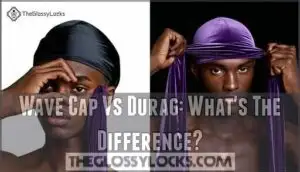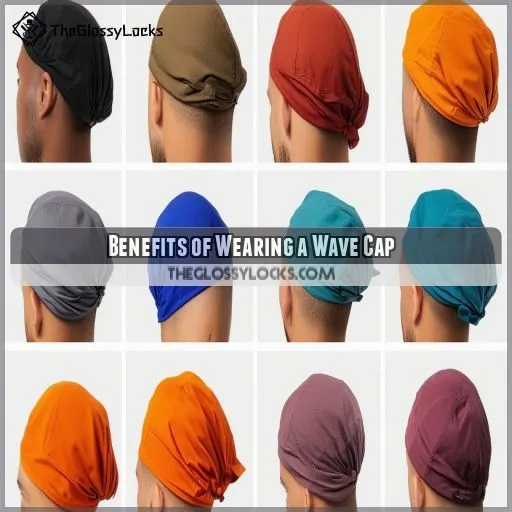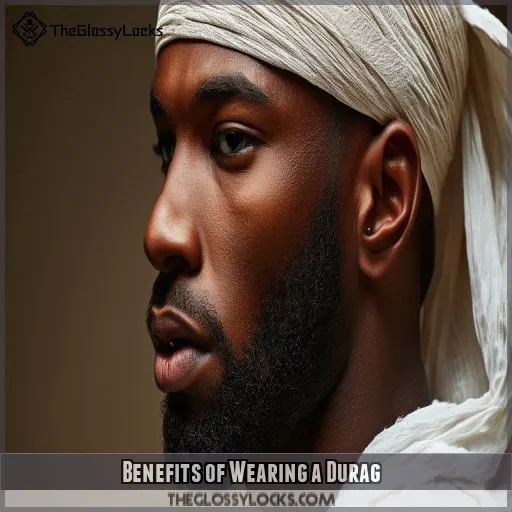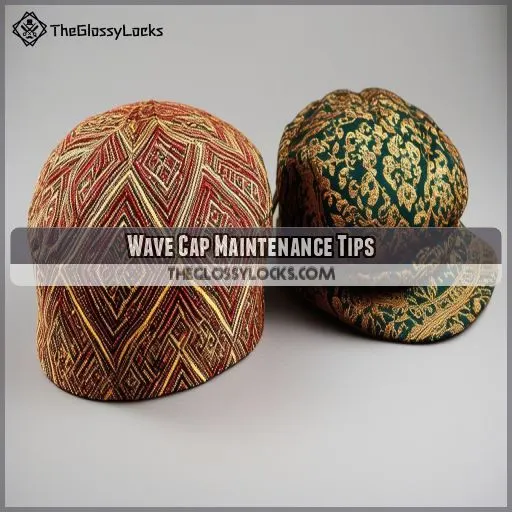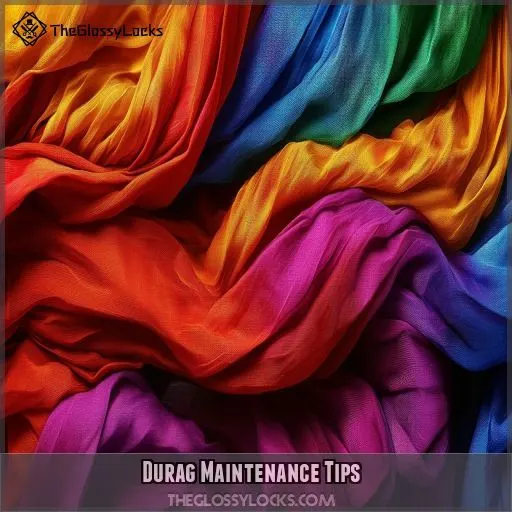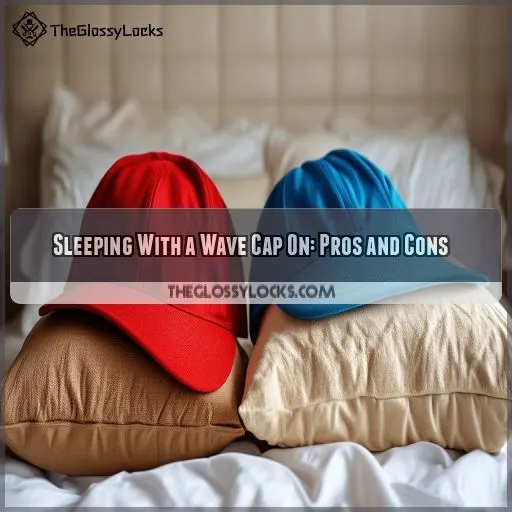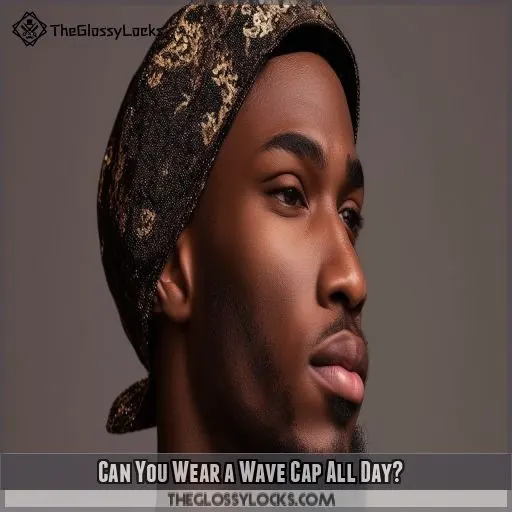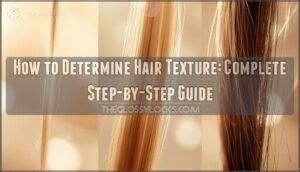This site is supported by our readers. We may earn a commission, at no cost to you, if you purchase through links.

Both have benefits unto themselves but require an understanding of their differences. Wave caps will keep your waves on point, while durags reduce friction and make them grow out.
We’re going to compare these hair essentials by looking at both of their strengths and uses. By the end, you will know which one befits your hair needs and your own personal lifestyle.
Table Of Contents
- Key Takeaways
- Wave Cap Vs Durag: What’s the Difference?
- Benefits of Wearing a Wave Cap
- Benefits of Wearing a Durag
- Wave Cap Maintenance Tips
- Durag Maintenance Tips
- Sleeping With a Wave Cap On: Pros and Cons
- Can You Wear a Wave Cap All Day?
- Frequently Asked Questions (FAQs)
- Is it good to sleep with a wave cap on?
- Can you wear a wave cap all day?
- Do you really need a durag for waves?
- Does a wave cap help your hair grow?
- Can wearing wave caps or durags cause hair thinning?
- Are there specific hairstyles that work better with each?
- How do wave caps and durags affect different hair textures?
- Can women use wave caps or durags for hair maintenance?
- Are there cultural considerations when choosing between wave caps and durags?
- Conclusion
Key Takeaways
- Wave caps and durags are like the Batman and Robin of hair care – both awesome, but with different superpowers. Wave caps offer a snug fit for keeping those waves on point, while durags are the friction-fighting champions that help your hair grow.
- Material matters, folks! Wave caps are usually made of nylon or spandex, giving you that tight hug for your hair. Durags, on the other hand, come in polyester, silk, or velvet – fancy, right? It’s like choosing between a comfy t-shirt and a silk robe for your head.
- Sleeping with a wave cap on is like tucking your waves into bed – they wake up looking fresh and ready to go. But be careful not to make it too tight, or you might give your scalp a nightmare!
- When it comes to all-day wear, wave caps are the marathon runners of headgear. They’re breathable and comfortable for extended use. Durags, while great for protection, might leave you feeling like you’ve got a koala bear hugging your head after a while.
Wave Cap Vs Durag: What’s the Difference?
When it comes to taking care of your hair, wave caps and durags are quite popular; however, they aren’t created equally. Wave caps, primarily fabricated from nylon or spandex, give a really snug fit that’s most suitable for keeping your wave pattern in place. They can be removed or put on easily, making them sturdy for quick touchups. On the other hand, durags are made mostly from polyester, silk, and velvet. They also fit looser, with a much firmer hold than their wave cap counterparts. They’re designed for serious wave enthusiasts who need to really lock in their style.
While wave caps will generally not leave lines on your forehead, durags really flex their muscles in the versatility style department since you can tie them differently to suit your looks. On the other hand, durags do need a little more care to prevent line formation. Both have benefits for hair health, but it’ll be driven with what you need in terms of hair care and style.
Benefits of Wearing a Wave Cap
When you wear a wave cap, you’re not just making a fashion statement – you’re investing in the health and style of your hair. Wave caps offer multiple benefits, including protecting your hair and scalp from external elements, maintaining your desired wave pattern, and potentially preventing hair loss through reduced friction and exposure.
Protecting Hair and Scalp
Wave caps offer superior hair protection compared to durags. They shield your locks from external elements, reducing hair breakage and wave damage.
By creating a barrier between your hair and the environment, wave caps minimize scalp irritation and promote healthy hair growth. Unlike durags, they’re less likely to cause line formation.
Incorporating a wave cap into your hair care routine is a smart move for maintaining your hair’s health and appearance.
Maintaining Wave Pattern
Now that your hair and scalp are protected, let’s deal with maintaining those waves. Wave caps excel in keeping your hard-earned pattern. Here is why they’re your go-to for wave maintenance:
- Snug fit compresses hair, reinforcing wave formation
Breathable material for moisture control and perfect wave health.
• Versatile design accommodates multiple wave patterns: 360, 540, and 720.
• Durable construction to stand frequent use and outlast most durags.
It is way more durable, comfortable, and affordable than durags; hence, wave caps offer the best option for answering wave care consistently.
Preventing Hair Loss
Wave caps can be your secret weapon against hair loss. They protect your hair from friction and breakage, potentially reducing shedding.
While durags offer similar benefits, wave caps‘ snug fit provides superior coverage. Their effectiveness in preventing hair loss is comparable to other hair products, but with added style points.
When considering alternatives, remember that wave caps pack a punch in both protection and fashion. Embrace the power of this hair-saving headgear!
Benefits of Wearing a Durag
You’ll find that wearing a durag offers significant benefits for your hair care routine. It provides excellent scalp protection, reduces friction that can damage your hair, and may even promote hair growth by maintaining moisture and preventing breakage.
Scalp Protection
While wave caps offer protection, durags take scalp care to the next level.
Premium polyester durags provide maximum compression, shielding your scalp from environmental stressors. Their moisture-wicking properties prevent scalp irritation and hair breakage, safeguarding your follicles from damage.
High-quality fabric allows air to pass, maintaining hygiene. You’ll experience unparalleled scalp protection, keeping your hair game strong and your confidence soaring.
It’s like a fortress for your follicles!
Reducing Friction
While durags protect your scalp, they’re also champions at reducing friction. By creating a smooth barrier between your hair and external factors, durags prevent damage that can lead to breakage and hair loss.
Unlike wave caps, durags with extra-long straps offer superior coverage, acting as a sleep cap to minimize scalp irritation.
At amazing prices, these versatile accessories are your hair’s best friend, shielding it from daily wear and tear.
Hair Growth Promotion
Wearing a durag will definitely help in the growth of hair. They offer protection, hence giving the best environment for your locks to thrive. Here is how they do it in respect to promoting hair growth:
- Reduced friction and breakage
- Lock moisture in your hair and scalp
- Prevent environmental damage
- Maintain wave patterns while reducing stress on hair
Durags provide better protection to the scalp than wave caps, so they’re very good for people who are concerned about hair loss and looking to maintain their waves.
Wave Cap Maintenance Tips
Properly looking after a wave cap first involves an understanding of the material composition followed by proper techniques of care. Now, let’s delve into some of the important facets of wave cap maintenance: material and construction, usage and care guidelines, and tips on choosing and styling your wave cap to keep it in optimal condition.
Material and Construction
Wave caps are typically made from nylon or spandex, offering durability and comfort. Their construction focuses on moisture-wicking and breathability, essential for maintaining healthy hair. Let’s compare wave caps and durags:
| Feature | Wave Cap | Durag |
|---|---|---|
| Material | Nylon/Spandex | Polyester/Silk |
| Fit | Tighter | Looser |
| Cost | Lower | Higher |
| Breathability | High | Moderate |
Choose wisely based on your needs and budget. Remember, the right headgear can be your ticket to hair freedom and style power!
Usage and Care
Now that you know what’s in wave caps, let’s get into how to use them properly and the proper care. Maintenance is where all the differences are made between wave caps and durags, so here are three major tips I’ve pertaining to wave cap care:
- Mild detergent cleaning regularly
- Air-dry to prevent damage
- Put it in a cool, dry place.
Choosing and Styling
When choosing between wave caps and durags, consider the material differences. Wave caps are typically made of synthetic fibers, while durags are often polyester.
Fit-wise, wave caps offer a tighter hold, whereas durags are looser. For your hair care routine, wave caps excel in brushing, while durags protect during the process.
Maintenance is easier with wave caps, but durags require more delicate care.
Style tips: wash with mild shampoo, use moisturizing products, and avoid over-brushing.
Prices vary, so compare options for the best value.
Durag Maintenance Tips
Keep your durag in the best of conditions by following these maintenance tips: wash regularly with light detergents in lukewarm water, and avoid strong chemicals, as they may be harsh on the fabric. Allow it to air-dry or hand-dry; don’t machine-dry. Stores well when neatly folded into some clean, dry place.
For optimal care, take into account these durag maintenance essentials.
- Invest in multiple durags to rotate wear and extend their lifespan
- Use a soft-bristled brush to gently remove dust and debris
• Apply fabric protector spray to protect from stains and water
Choose from materials such as silk, polyester, and velvet while selecting a durag. Each has varied benefits associated with the use case of both hair care and style. Tying methods will come along the way when you experiment with what works best for both your hair type and desired look. Note, however, that a well-worn-out durag doesn’t only give off a better appearance but also gives better protection to the hair.
Sleeping With a Wave Cap On: Pros and Cons
Weigh the pros and cons of sleeping in a wave cap just to get the perfect hairstyle in the morning. This will help hold your waves in place and, at the same time, reduce frizz overnight. The cap, when worn over extended periods, can result in scalp irritation or even hair breakage if special care isn’t taken for its management.
Benefits of Sleeping With a Wave Cap
Sleeping in a wave cap can be an ingenious way to create a hair routine. You’ll wake up the following morning with waves in line and less need for styling every day.
How comfortable you are when spending the night in one wholly depends on the material used in the cap.
It protects your hair from friction created by the pillow, thus avoiding breakage and frizz. Moreover, it helps lock in moisture to keep your hair hydrated while you catch those Z’s.
Potential Drawbacks of Wearing a Wave Cap Overnight
While wearing a wave cap overnight can maintain your waves, it’s not without drawbacks.
You might experience scalp irritation from prolonged compression, leading to discomfort. Hair breakage can occur if the cap’s too tight, especially on fragile strands.
Product build-up is another concern, as oils and styling products accumulate. Over time, this can cause hair damage.
To minimize risks, opt for a looser fit and clean your cap regularly.
Can You Wear a Wave Cap All Day?
You can comfortably sport a wave cap all day and not be worried because it fits perfectly, has good ventilation, and will easily get through an entire day. However, using the cap for extended periods requires such factors as scalp health, hair moisture, and daily activities in making a decision.
Suitability for Prolonged Wear
You can wear a wave cap all day, but do remember comfort and breathability. Although wave caps are designed to be worn all day, it may potentially create irritation and buildup that would hugely affect the way your hair appears.
In this regard, regular maintenance is necessary to keep your cap fresh. Ensure that you allow some breathing time for the scalp and adjust it during the day so it fits comfortably enough to get the best form of waves.
Comfort and Convenience Factors
Wave caps deliver comfort and fitting for day-to-day wear since they’re adjustable, breathable, and secure. With durags, extended usage could be irritating; wave caps won’t leave any marks or feelings of uneasiness on your skin. Their lightweight build makes you hardly feel like you’re wearing one at all, so attention isn’t drawn away from how you live your day.
Frequently Asked Questions (FAQs)
Is it good to sleep with a wave cap on?
You will definitely benefit from sleeping in a wave cap, as it protects your hair, holds the wave pattern, and reduces friction. Just be careful not to have it too tight, for this is what can result in pain or further problems at the hairline. Best of all is when it’s made of a breathable material.
Can you wear a wave cap all day?
You can wear a wave cap all day, but it’s not ideal. While it protects your waves, prolonged use may cause scalp irritation or hair breakage. Take breaks to let your scalp breathe and moisturize regularly.
Do you really need a durag for waves?
While durags offer superior hold, wave caps can suffice. You don’t absolutely need a durag for waves, but they’re beneficial. Wave caps provide adequate protection and maintenance, though durags excel in creating and preserving intricate wave patterns.
Does a wave cap help your hair grow?
While a wave cap doesn’t directly promote hair growth, it can indirectly help by protecting your hair from damage. It reduces friction, locks in moisture, and shields your waves from environmental stressors, potentially leading to healthier hair over time.
Can wearing wave caps or durags cause hair thinning?
John noticed thinning after wearing tight caps daily. While wave caps and durags don’t directly cause hair loss, excessive tension can lead to traction alopecia. You’re better off wearing them loosely and taking breaks to protect your hairline.
Are there specific hairstyles that work better with each?
Certain hairstyles complement wave caps or durags better. Short, texturized cuts work well with wave caps, maintaining 360 waves. Durags excel with longer styles, protecting braids, twists, or locs. Choose based on your hair length and desired look.
How do wave caps and durags affect different hair textures?
Your hair texture influences how wave caps and durags work for you. Coarse hair benefits from durags’ stronger hold, while fine hair may prefer wave caps’ gentler grip. Both can help maintain waves, but effectiveness varies by hair type.
Can women use wave caps or durags for hair maintenance?
Ever wondered if hair care knows gender? You bet it doesn’t! Women can absolutely use wave caps or durags for hair maintenance. These versatile tools help protect styles, reduce frizz, and promote wave patterns, regardless of gender.
Are there cultural considerations when choosing between wave caps and durags?
Keep in mind the cultural considerations that you’ll also have to make regarding headwear. Wave caps and durags are borrowed from African American communities. Now, they’re very widespread; however, knowing how they came about will help in making a decision.
Conclusion
Take, for example, John the barber, hailed as the lord of waves. His secret—expertise in these products—is understanding that each has its purpose.
When deciding between a wave cap and a durag, remember your specific hair needs. Wave caps are superb at maintaining patterns. Durags, on the other hand, reduce friction and, in turn, can increase growth. At the same time, both provide protection for the scalp and have a well-deserved place in any hair routine.
Experiment with each one and see what works best for you. In good hands, these tools can be very beneficial to the health and appearance of your hair.

